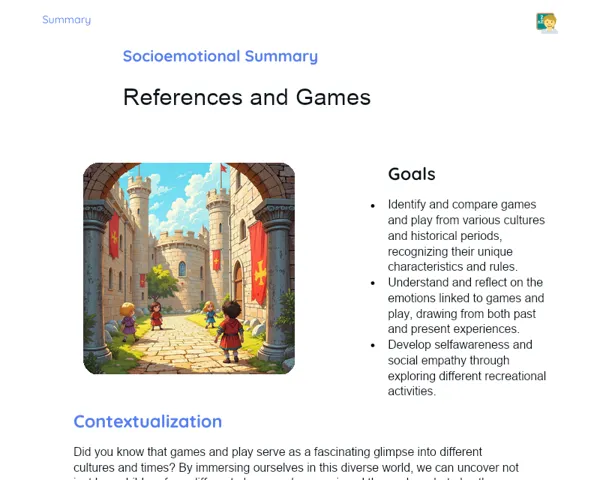Summary Tradisional | Rocks: Characteristics
Contextualization
Rocks are the essential building blocks of our Earth. They make up the crust and play a crucial role in numerous geological processes. By studying rocks, we can gain insights into our planet's history, including events like volcanic eruptions, mountain formation, and continental drift. Rocks hold valuable information about the long processes that have shaped the Earth over millions of years.
It's key to understand that there are three main types of rocks: igneous, sedimentary, and metamorphic. Each type forms through different processes and has unique characteristics that significantly impact our landscapes. For instance, granite, an igneous rock, is commonly used in construction due to its strength and aesthetic appeal, while sedimentary rocks like sandstone are well-known for housing fossils that give us clues about life in the past. Grasping these processes and characteristics is fundamental to physical geography and essential for interpreting the landscapes we see around us.
To Remember!
Igneous Rocks
Igneous rocks form from the cooling and solidifying of magma or lava. Magma resides below the Earth's surface, whereas lava is magma that erupts to the surface. We can categorise igneous rocks into two main types: intrusive and extrusive.
Intrusive igneous rocks, or plutonic rocks, cool slowly beneath the Earth's crust, allowing larger mineral crystals to develop. A well-known example of this is granite, which is popular in construction due to its durability and good looks.
Extrusive igneous rocks, or volcanic rocks, form when lava cools rapidly on the Earth's surface, resulting in tiny crystals that are often hard to spot. Basalt is a common example of an extrusive rock and is often found in solidified lava flow formations.
-
Formed from the cooling and solidification of magma or lava.
-
Classified as intrusive (plutonic) and extrusive (volcanic).
-
Examples: Granite (intrusive) and Basalt (extrusive).
Sedimentary Rocks
Sedimentary rocks are formed through the deposition and compaction of sediments over time. These sediments can include bits of other rocks, minerals, organic material, or chemical deposits. The processes of erosion, transport, deposition, and lithification are crucial to the formation of these rocks.
Erosion breaks down existing rocks, creating sediments that are then moved by wind, water, or ice. These sediments settle in layers, often in water bodies like rivers, lakes, and oceans. Over time, the weight of the upper layers compresses the sediments, while minerals dissolved in the water help to bind the material together.
Sandstone is a classic example of a sedimentary rock, made mainly of quartz grains, while limestone, which often contains fossils, is another important sedimentary rock used in cement production.
-
Formed by the deposition and compaction of sediments.
-
Erosion, transport, deposition, and lithification processes are essential.
-
Examples: Sandstone and Limestone.
Metamorphic Rocks
Metamorphic rocks are created by transforming existing rocks under high pressures and temperatures, without fully melting them. This change, known as metamorphism, can alter the rock's structure and mineral makeup significantly.
Metamorphism can happen due to several influences, such as tectonic pressures from mountain building, heat from nearby magma, or the weight of overlying rock layers. The intensity of this metamorphism can vary, leading to different levels of mineral reorganisation.
Marble is a classic metamorphic rock that forms from limestone when subjected to significant pressure and temperature, while slate originates from shale and is often used for roofing and flooring because it can be easily split into thin sheets.
-
Formed by the transformation of existing rocks under high pressures and temperatures.
-
This process is known as metamorphism.
-
Examples: Marble (from limestone) and Slate (from shale).
Influence of Rocks on Landscape
The different kinds of rocks play a major role in shaping and modifying the landscape. The composition and durability of rocks influence how natural processes, like erosion and tectonic activity, sculpt the Earth's surfaces.
Igneous rocks, like granite, often create strong mountains and hills due to their resistance to erosion. In contrast, sedimentary rocks such as sandstone and limestone are more vulnerable to erosion, which can lead to gentler landscapes and deeper valleys. Depending on their make-up and level of metamorphism, metamorphic rocks can contribute to a range of terrains, from steep mountains to rolling plains.
The diversity of rock types in a region can result in varied landforms, affecting water flow, plant life, and even local climates. For example, areas rich in limestone can develop impressive cave systems and karst formations due to its solubility in acidic waters.
-
Different types of rocks influence the Earth's relief.
-
Igneous rocks create strong mountains and hills.
-
Sedimentary rocks lead to smoother landscapes and deep valleys.
Key Terms
-
Igneous Rocks: Formed by the cooling and solidification of magma or lava.
-
Sedimentary Rocks: Formed by the deposition and compaction of sediments.
-
Metamorphic Rocks: Formed by the transformation of existing rocks under high pressures and temperatures.
-
Erosion: The process of wearing down rocks and moving sediments.
-
Lithification: The process by which sediments turn into solid rock.
-
Metamorphism: The process of changing one rock type into another under high pressures and temperatures.
-
Granite: An intrusive igneous rock created by slow cooling of magma.
-
Basalt: An extrusive igneous rock formed by the quick cooling of lava.
-
Sandstone: A sedimentary rock composed mainly of quartz grains.
-
Limestone: A sedimentary rock that often contains fossils and is used in cement production.
-
Marble: A metamorphic rock created from limestone.
-
Slate: A metamorphic rock created from shale.
Important Conclusions
In this lesson, we explored the three main types of rocks: igneous, sedimentary, and metamorphic. We learned that igneous rocks form from the cooling of magma or lava, and can be intrusive or extrusive like granite and basalt. Sedimentary rocks are created from the deposition and compaction of sediments, often containing fossils, for instance, sandstone and limestone. Metamorphic rocks emerge from the transformation of existing rocks under significant pressures and temperatures, exemplified by marble and slate. We also grasped how these various rock types shape and alter landscapes, forming mountains, valleys, and plains. This understanding is essential for comprehending the geological processes that have shaped our planet and the distribution of natural resources. We urge students to dig deeper into the topic to enrich their knowledge of geology and its relevance in the real world.
Study Tips
-
Review lesson materials, including slides and rock samples, to reaffirm your understanding of how each type of rock forms.
-
Utilise extra resources like videos and documentaries on geology to visualise the processes discussed in class and see practical examples of rock formations.
-
Practice identifying different types of rocks through actual samples or images, concentrating on the traits that distinguish igneous, sedimentary, and metamorphic rocks.



